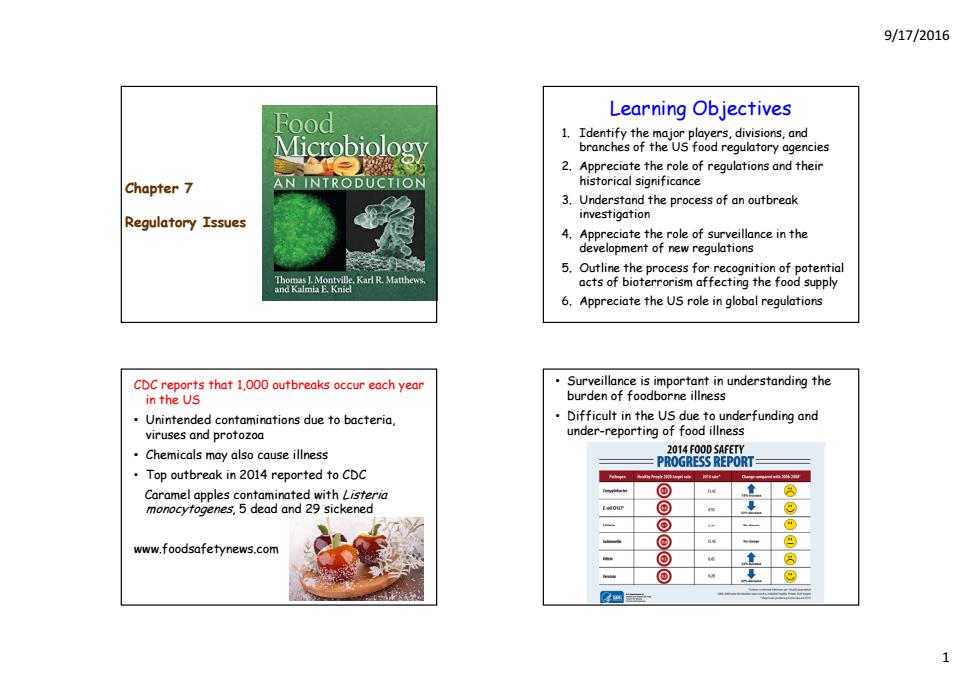
9/17/2016 Food Learning Objectives 1.Identify the major players,divisions,and branches of the US food regulatory agencies 2.Appreciate the role of regulations and their Chapter 7 AN INTRODUCTION historical significance 3.Understand the process of an outbreak Regulatory Issues investigation 4.Appreciate the role of surveillance in the development of new regukations 5.Outline the process for recognition of potential acts of bioterrorism affecting the food supply Appreciate the US role in global regulations CDC reports that 1,000 outbreaks occur each year Surveillance is important in understanding the in the US burden of foodborne illness Unintended contaminations due to bacteria, Difficult in the US due to underfunding and viruses and protozoa under-reporting of food illness Chemicals may also cause illness 2014 FOOD SAFETY PROGRESS REPORT: Top outbreak in 2014 reported to CDC Caramel apples contaminated with Listeria monocytogenes,5 dead and 29 sickened www.foodsafetynews.com
9/17/2016 1 Chapter 7 Regulatory Issues Learning Objectives 1. Identify the major players, divisions, and branches of the US food regulatory agencies 2. Appreciate the role of regulations and their historical significance 3. Understand the process of an outbreak investigation 4. Appreciate the role of surveillance in the d l f l i development of new regulations 5. Outline the process for recognition of potential acts of bioterrorism affecting the food supply 6. Appreciate the US role in global regulations CDC reports that 1,000 outbreaks occur each year in the US • Unintended contaminations due to bacteria, viruses and protozoa • Chemicals may also cause illness • Top outbreak in 2014 reported to CDC Caramel apples contaminated with Listeria monocytogenes, 5 dead and 29 sickened www.foodsafetynews.com • Surveillance is important in understanding the burden of foodborne illness • Difficult in the US due to underfunding and under-reporting of food illness
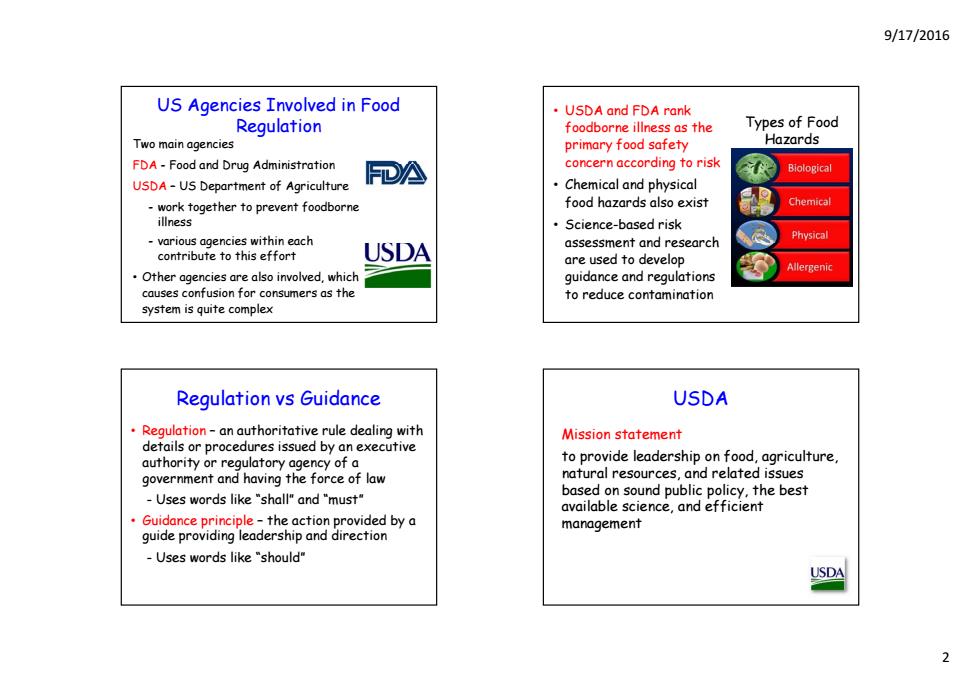
9/17/2016 US Agencies Involved in Food ·USDA and FDA rank Regulation foodborne iliness as the Types of Food Two main agencies primary food safety Hazards FDA-Food and Drug Administration concern according to risk Biological USDA-US Department of Agriculture 巴A Chemical and physical work together to prevent foodborne food hazards also exist Chemical illness ·Science-based risk various agencies within each Physical contribute to this effort USDA assessment and research are used to develop Other agencies are also involved,which Allergenic guidance and regulations causes confusion for consumers as the to reduce contamination system is quite complex Regulation vs Guidance USDA Regulation-an authoritative rule dealing with Mission statement details or procedures issued by an executive authority or regulatory agency of a to provide leadership on food,agriculture. government and having the force of law natural resources,and related issues -Uses words like "shall"and"must" based on sound public policy,the best available science,and efficient Guidance principle-the action provided by a management guide providing leadership and direction -Uses words like "should" USDA
9/17/2016 2 US Agencies Involved in Food Regulation Two main agencies FDA - Food and Drug Administration USDA – US Department of Agriculture - work together to prevent foodborne illness - various agencies within each contribute to this effort • Other agencies are also involved, which causes confusion for consumers as the system is quite complex • USDA and FDA rank foodborne illness as the primary food safety concern according to risk Types of Food Hazards • Chemical and physical food hazards also exist • Science-based risk assessment and research are used to develop guidance and regulations to reduce contamination Regulation vs Guidance • Regulation – an authoritative rule dealing with details or procedures issued by an executive authority or regulatory agency of a government and having the force of law - Uses words like “shall” and “must” • Guidance p p rinci le – the action p y rovided by a guide providing leadership and direction - Uses words like “should” USDA Mission statement to provide leadership on food, agriculture, natural resources, and related issues based on sound public policy, the best available science, and efficient management

9/17/2016 USDA USDA Composed of 17agencies Food programs and services: 15 offices 1.Meat and poultry safety Mission areas 2.Food safety information 1.Farm and foreign agricultural services 3.Food preservation and home canning assistance 2.Food,nutrition,and consumer services 4.Child nutrition programs 3.Food safety 5.Supplemental nutrition assistance 4.Marketing and regulatory programs programs 5.Natural resources and environment 6. Economic research on food safety- 6.Research,education,and economics Economic Research Service 7.Rural development USDA 7.Basic and applied aspects of food safety Agricultural Research Service FSIS Food Safety and Inspection Service Responsible for the safety and labeling of meats and poultry Regulates game meats such as venison, USDA ostrich,and snake Worked with FMIA-Federal Meat Inspection Act for>100 years USDA SIS
9/17/2016 3 Composed of USDA 17 agencies 15 offices Mission areas 1. Farm and foreign agricultural services 2. Food, nutrition, and consumer services 3. Food safety 4. Marketing and regulatory programs 5. Natural resources and environment 6. Research, education, and economics 7. Rural development USDA Food programs and services: 1. Meat and poultry safety 2. Food safety information 3. Food preservation and home canning assistance 4. Child nutrition programs 5. Supplemental nutrition assistance programs 6. Economic research on food safety - Economic Research Service 7. Basic and applied aspects of food safety – Agricultural Research Service FSIS Food Safety and Inspection Service • Responsible for the safety and labeling of meats and poultry • Regulates game meats such as venison, ostrich, and snake • Worked with FMIA - Federal Meat I s ti A t f > 100 s I n spection A ct for > 100 year s
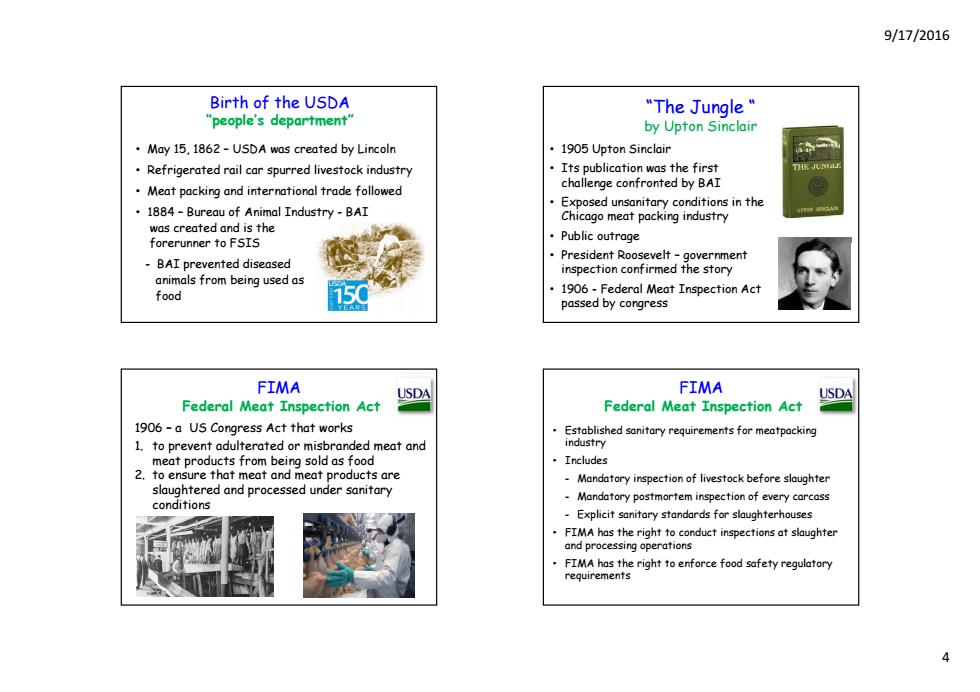
9/17/2016 Birth of the USDA "The Jungle" "people's department by Upton Sinclair May 15,1862-USDA was created by Lincoln ·19o5 Upton Sinclair Refrigerated rail car spurred livestock industry Its publication was the first Meat packing and international trade followed challenge confronted by BAI 1884-Bureau of Animal Industry-BAI Exposed unsanitary conditions in the Chicago meat packing industry was created and is the forerunner to FSIS Public outrage BAI prevented diseased President Roosevelt-government inspection confirmed the story animals from being used as food 1906-Federal Meat Inspection Act passed by congress FIMA USDA FIMA USDA Federal Meat Inspection Act Federal Meat Inspection Act 1906-a US Congress Act that works Established sanitary requirements for meatpacking 1.to prevent adulterated or misbranded meat and industry meat products from being sold as food ·Includes 2.to ensure that meat and meat products are -Mandatory inspection of livestock before slaughter slaughtered and processed under sanitary Mandatory postmortem inspection of every carcass conditions Explicit sanitary standards for slaughterhouses FIMA has the right to conduct inspections at slaughter and processing operations FIMA has the right to enforce food safety regulatory requirements
9/17/2016 4 Birth of the USDA “people’s department” • May 15, 1862 – USDA was created by Lincoln • Refrigerated rail car spurred livestock industry • Meat packing and international trade followed • 1884 – Bureau of Animal Industry - BAI was created and is the forerunner to FSIS - BAI prevented diseased animals from being used as food “The Jungle “ by Upton Sinclair • 1905 Upton Sinclair • It bli ti th fi t Its publication was the first challenge confronted by BAI • Exposed unsanitary conditions in the Chicago meat packing industry • Public outrage • President Roosevelt – government inspection confirmed the story • 1906 - Federal Meat Inspection Act passed by congress FIMA Federal Meat Inspection Act 1906 – a US Congress Act that works 1. to prevent adulterated or misbranded meat and meat products from being sold as food 2. to ensure that meat and meat products are slaughtered and processed under sanitary conditions FIMA Federal Meat Inspection Act • Established sanitary requirements for meatpacking industry • Includes - Mandatory inspection of livestock before slaughter - Mandatory postmortem inspection of every carcass - Explicit sanitary standards for slaughterhouses • FIMA has the right to conduct inspections at slaughter and processing operations • FIMA has the right to enforce food safety regulatory requirements
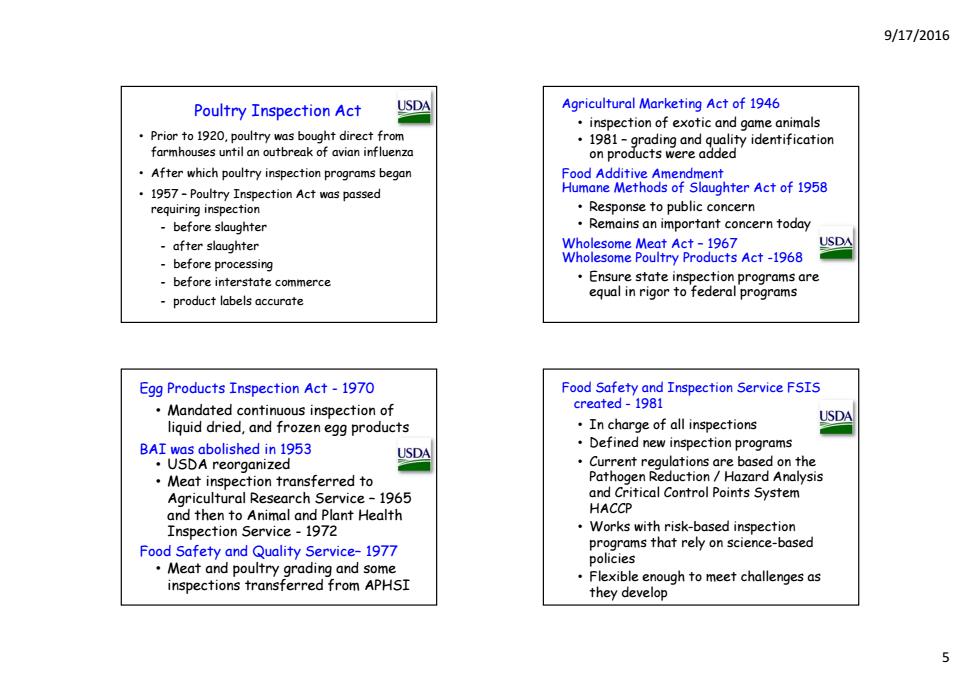
9/17/2016 Poultry Inspection Act USDA Agricultural Marketing Act of 1946 inspection of exotic and game animals Prior to 1920,poultry was bought direct from .1981-grading and quality identification farmhouses until an outbreak of avian influenzo on products were added After which poultry inspection programs began Food Additive Amendment .1957-Poultry Inspection Act was passed Humane Methods of Slaughter Act of 1958 requiring inspection Response to public concern before slaughter Remains an important concern today -after slaughter Wholesome Meat Act-1967 USDA -before processing Wholesome Poultry Products Act-1968 before interstate commerce Ensure state inspection programs are product labels accurate equal in rigor to federal programs Egg Products Inspection Act-1970 Food Safety and Inspection Service FSIS Mandated continuous inspection of created-1981 In charge of all inspections USDA liquid dried,and frozen egg products BAI was abolished in 1953 Defined new inspection programs USDA ·USDA reorganized Current regulations are based on the Meat inspection transferred to Pathogen Reduction Hazard Analysis Agricultural Research Service-1965 and Critical Control Points System and then to Animal and Plant Health HACCP Inspection Service-1972 Works with risk-based inspection Food Safety and Quality Service-1977 programs that rely on science-based policies Meat and poultry grading and some inspections transferred from APHSI Flexible enough to meet challenges as they develop
9/17/2016 5 • Prior to 1920, poultry was bought direct from farmhouses until an outbreak of avian influenza Poultry Inspection Act • After which poultry inspection programs began • 1957 – Poultry Inspection Act was passed requiring inspection - before slaughter - after slaughter - before processing - before interstate commerce - product labels accurate Agricultural Marketing Act of 1946 • inspection of exotic and game animals • 1981 – grading and quality identification on products were added Food Additive Amendment Humane Methods of Slaughter Act of 1958 • Response to public concern • Remains an important concern today Wholesome Meat Act – 1967 Wholesome Poultry Products Act -1968 • Ensure state inspection programs are equal in rigor to federal programs Egg Products Inspection Act - 1970 • Mandated continuous inspection of liquid dried, and frozen egg products BAI was abolished in 1953 • USDA reorganized • Meat inspection transferred to Agricultural Research Service – 1965 and then to Animal and Plant Health I i S i Inspection Service - 1972 Food Safety and Quality Service– 1977 • Meat and poultry grading and some inspections transferred from APHSI Food Safety and Inspection Service FSIS created - 1981 • In charge of all inspections • D f n n w nsp ct on programs e fined n ew insp ection programs • Current regulations are based on the Pathogen Reduction / Hazard Analysis and Critical Control Points System HACCP • Works with risk-based inspection programs that rely on science-based policies • Flexible enough to meet challenges as they develop
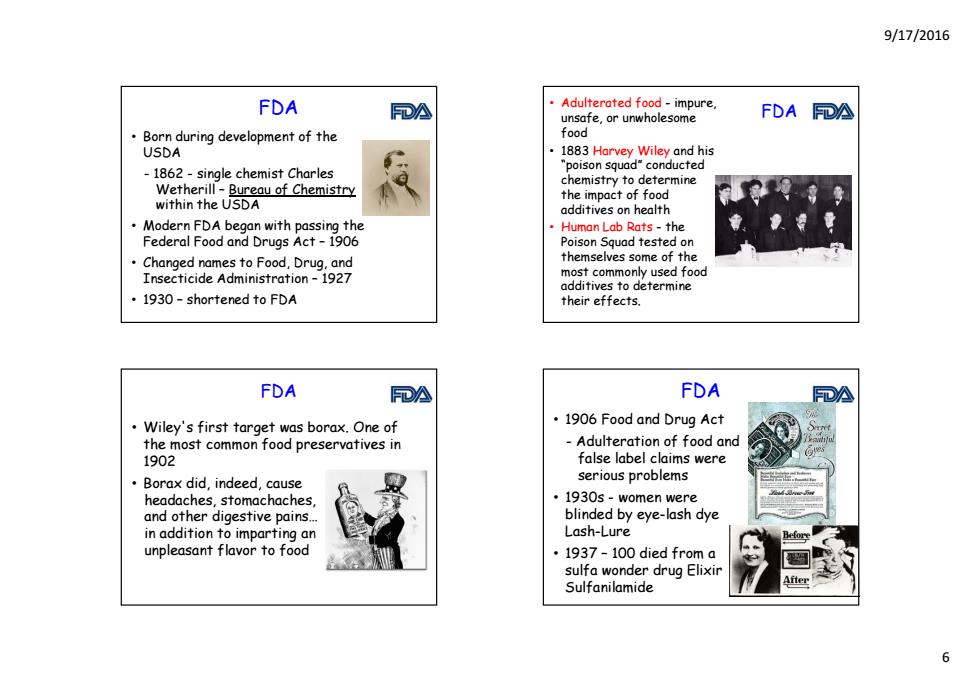
9/17/2016 FDA 元A Adulterated food-impure unsafe,or unwholesome FDA FDA Born during development of the food USDA 1883 Harvey Wiley and his -1862-single chemist Charles poison squad"conducted chemistry to determine Wetherill-Bureau of Chemistry the impact of food within the USDA additives on health Modern FDA began with passing the ·Human Lab Rats-the Federal Food and Drugs Act-1906 Poison Squad tested on Changed names to Food,Drug,and themselves some of the Insecticide Administration-1927 most commonly used food additives to determine 1930-shortened to FDA their effects. FDA FDA FDA Wiley's first target was borax.One of ·1906 Food and Drug Act the most common food preservatives in Adulteration of food and 1902 false label claims were Borax did,indeed,cause serious problems headaches,stomachaches, ·1930s-women were and other digestive pains. blinded by eye-lash dye in addition to imparting an Lash-Lure unpleasant flavor to food 1937-100 died from a sulfa wonder drug Elixir Sulfanilamide 6
9/17/2016 6 FDA • Born during development of the USDA - 1862 - single chemist Charles Wetherill – Bureau of Chemistry within the USDA • Modern FDA began with passing the Federal Food and Drugs Act – 1906 • Changed names to Food, Drug, and Insecticide Administration – 1927 • 1930 – shortened to FDA FDA • Adulterated food - impure, unsafe, or unwholesome food • 1883 Harvey Wiley and his “poison squad poison squad conducted ” conducted chemistry to determine the impact of food additives on health • Human Lab Rats - the Poison Squad tested on themselves some of the most commonly used food additives to determine their effects. FDA • Wiley's first target was borax. One of the most common food preservatives in 1902 • Borax did, indeed, cause headaches, stomachaches, and other digestive pains… in addition to imparting an unpleasant flavor to food FDA • 1906 Food and Drug Act - Adulteration of food and false label claims were serious problems • 1930s - women were blinded by eye-lash dye L h as h-Lure • 1937 – 100 died from a sulfa wonder drug Elixir Sulfanilamide

9/17/2016 FDA 色A FDA 1990s-Regulatory reforms with numerous 1938-Food,Drug,and Cosmetic Act passed Congressional investigations and reports -Brought better control for cosmetics,medical No changes until 2010 devices and food additives 2011-Food Safety Modernization Act By 190.nearly half of US food supply was subject (FSMA)signed by Pres.Obama to standards response to the 48 million Americans who suffer Rep.James Delaney-new laws from foodborne illness each year 1954-pesticide residues mstoensure the U.S.food supply is safe by 1958-food additives,carcinogens shifting the focus from responding to contamination to preventing it 1960-color additives Establish science-based standards for 1968-Animal Drug Amendments combined >safe production and harvesting of fruits and veterinary drugs and additives-Bureau of Animal vegetables Drugs >safe transportation of food FDA Responsibilities Most sweeping reform in 70 years! Ensures foods are safe,wholesome and sanitary Pe bergd of ll odd biological products medical devices Cosmetics electronics that emit radiation Regulates livestock and pet foods safety Regulates with the Environmental Protection Agency water safety Ensure these products are honestly,accurately,and informatively represented to the consumer
9/17/2016 7 FDA • 1938 – Food, Drug, and Cosmetic Act passed - Brought better control for cosmetics, medical devices and food additives • By 1960, nearly half of US food supply was subject to standards • Rep. James Delaney – new laws - 1954 – pesticide residues - 1958 – food additives carcinogens food additives, carcinogens - 1960 – color additives • 1968 – Animal Drug Amendments combined veterinary drugs and additives – Bureau of Animal Drugs FDA • 1990s – Regulatory reforms with numerous Congressional investigations and reports - No changes until 2010 • 2011 – F d f d Food Safety Modernization Act (FSMA) signed by Pres. Obama - response to the 48 million Americans who suffer from foodborne illness each year - aims to ensure the U.S. food supply is safe by shifting pg the focus from responding to contamination to preventing it - Establish science-based standards for safe production and harvesting of fruits and vegetables safe transportation of food Most sweeping reform in 70 years! FDA Responsibilities • Ensures foods are safe, wholesome and sanitary • Regulates labeling and safety of all food except meat and poultry • R l f f Regulates safety of - human and veterinary drugs - biological products - medical devices - Cosmetics - electronics that emit radiation • Regulates livestock and pet foods safety • Regulates with the Environmental Protection Agency water safety • Ensure these products are honestly, accurately, and informatively represented to the consumer
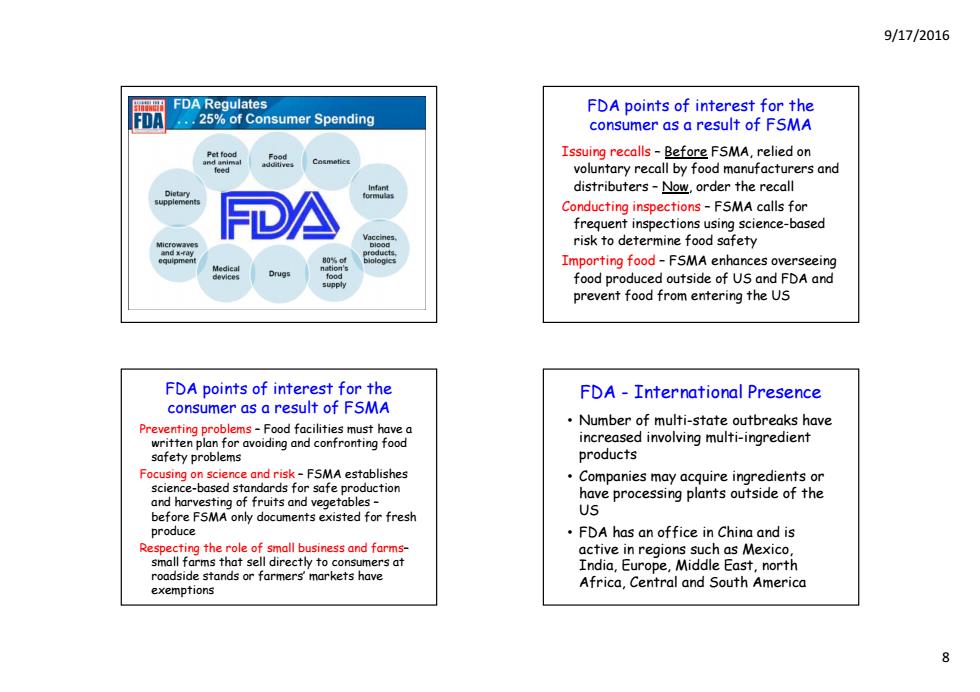
9/17/2016 FDA Requlates FDA points of interest for the FDA ..25%of Consumer Spending consumer as a result of FSMA Issuing recalls-Before FSMA,relied on voluntary recall by food manufacturers and distributers-Now,order the recall FDA Conducting inspections-FSMA calls for frequent inspections using science-based risk to determine food safety and x-r Importing food-FSMA enhances overseeing food produced outside of US and FDA and prevent food from entering the US FDA points of interest for the FDA-International Presence consumer as a result of FSMA Preventing problems-Food facilities must have a Number of multi-state outbreaks have written plan for avoiding and confronting food increased involving multi-ingredient safety problems products Focusing on science and risk-FSMA establishes Companies may acquire ingredients or science-based standards for safe production and harvesting of fruits and vegetables- have processing plants outside of the before FSMA only documents existed for fresh Us produce FDA has an office in China and is Respecting the role of small business and farms- active in regions such as Mexico, small farms that sell directly to consumers at roadside stands or farmers markets have India,Europe,Middle East,north Africa,Central and South America exemptions
9/17/2016 8 FDA points of interest for the consumer as a result of FSMA Issuing recalls – Before FSMA, relied on vol t ll b f d f t d luntary recall by food manufacturers and distributers – Now, order the recall Conducting inspections – FSMA calls for frequent inspections using science-based risk to determine food safety Importing food – FSMA enhances overseeing food produced outside of US and FDA and prevent food from entering the US FDA points of interest for the consumer as a result of FSMA Preventing problems – Food facilities must have a written p f g f gf lan for avoiding and confronting food safety problems Focusing on science and risk – FSMA establishes science-based standards for safe production and harvesting of fruits and vegetables – before FSMA only documents existed for fresh produce Respecting the role of small business and farms– small farms that sell directly to consumers at roadside stands or farmers’ markets have exemptions FDA - International Presence • Number of multi-state outbreaks have increased involving multi-ingredient products • Companies may acquire ingredients or have processing plants outside of the US • FDA h ffi i Chi d i FDA has an office in China and is active in regions such as Mexico, India, Europe, Middle East, north Africa, Central and South America
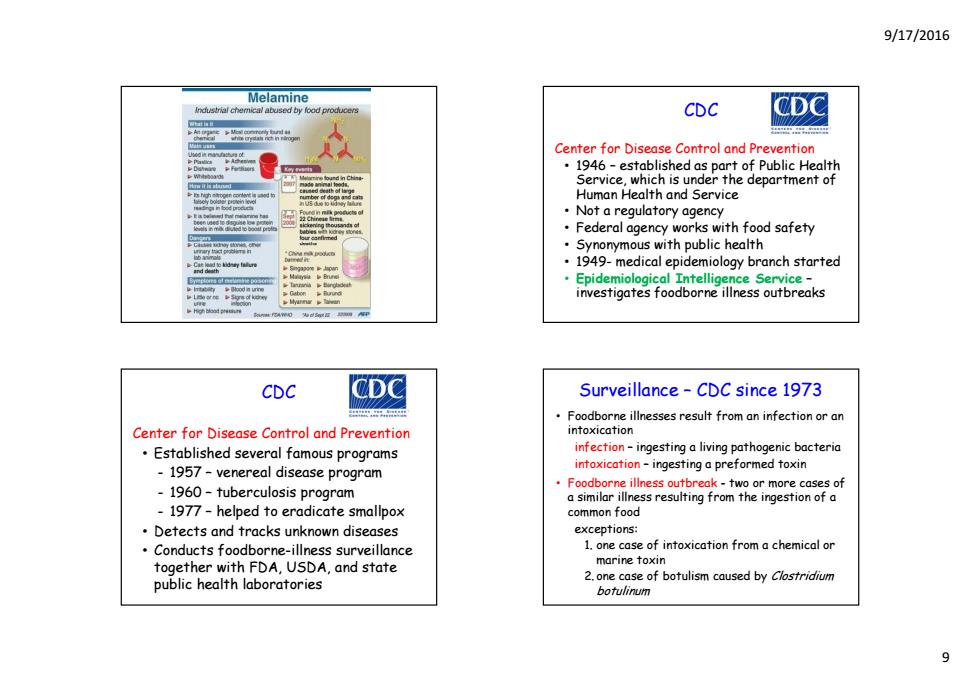
9/17/2016 Melamine CDC CDC Center for Disease Control and Prevention .1946-established as part of Public Health Service,which is under the department of Human Health and Service Not a regulatory agency Federal agency works with food safety Synonymous with public health 1949-medical epidemiology branch started Epidemiological Intelligence Service- investigates foodborne illness outbreaks CDC Surveillance-CDC since 1973 Foodborne illnesses result from an infection or an Center for Disease Control and Prevention intoxication Established several famous programs infection-ingesting a living pathogenic bacteria -1957-venereal disease program intoxication-ingesting a preformed toxin -1960-tuberculosis program Foodborne illness outbreak-two or more cases of a similar illness resulting from the ingestion of a -1977-helped to eradicate smallpox common food Detects and tracks unknown diseases exceptions: Conducts foodborne-illness surveillance 1.one case of intoxication from a chemical or together with FDA,USDA,and state marine foxin public health laboratories 2.one case of botulism caused by Clostridium botulinum
9/17/2016 9 CDC Center for Disease Control and Prevention • 1946 – established as part of Public Health Service, which is under the department of Human Health and Service • Not a regulatory agency • Federal agency works with food safety • Synonymous with public health • 1949- medical epidemiology branch started • Epidemiological Intelligence Service – investigates foodborne illness outbreaks CDC Center for Disease Control and Prevention • E bli h d l f Established several famous programs - 1957 – venereal disease program - 1960 – tuberculosis program - 1977 – helped to eradicate smallpox • D t t d t k k di Detects and tracks unknown diseases • Conducts foodborne-illness surveillance together with FDA, USDA, and state public health laboratories Surveillance – CDC since 1973 • Foodborne illnesses result from an infection or an intoxication infection – ingesting a living pathogenic bacteria intoxication – ingesting a preformed toxin • Foodborne illness outbreak - two or more cases of a similar illness resulting from the ingestion of a common food exceptions: 1. one case of intoxication from a chemical or marine toxin 2. one case of botulism caused by Clostridium botulinum
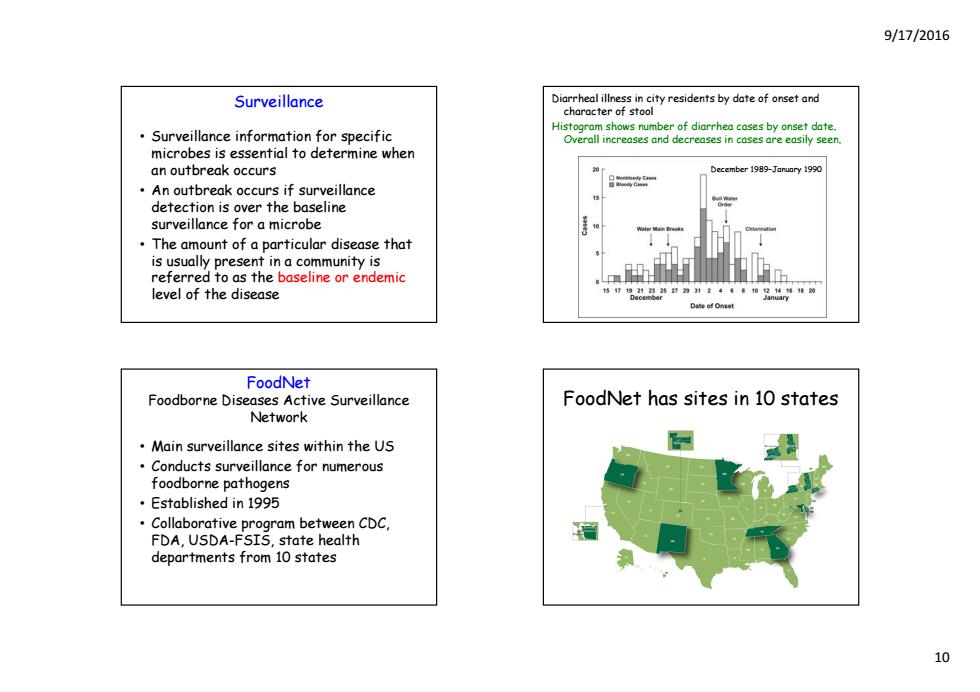
9/17/2016 Surveillance Diarrheal illness in city residents by date of onset and character of stoo Histogram shows number of diarrhea cases by onset date. Surveillance information for specific Overall increases and decreases in cases are easily seen. microbes is essential to determine when an outbreak occurs December 1989-Jaruary 1990 An outbreak occurs if surveillance 15 detection is over the baseline surveillance for a microbe The amount of a particular disease that is usually present in a community is referred to as the baseline or endemic level of the disease Date cf Onse FoodNet Foodborne Diseases Active Surveillance FoodNet has sites in 10 states Network Main surveillance sites within the US Conducts surveillance for numerous foodborne pathogens ·Established in1995 Collaborative program between CDC, FDA,USDA-FSIS,state health departments from 10 states 10
9/17/2016 10 Surveillance • Surveillance information for specific microbes is essential to determine when an b k out reak occurs • An outbreak occurs if surveillance detection is over the baseline surveillance for a microbe • The amount of a particular disease that is usually present in a community is referred to as the baseline or endemic level of the disease Diarrheal illness in city residents by date of onset and character of stool Histogram shows number of diarrhea cases by onset date. Overall increases and decreases in cases are easily seen. December 1989–January 1990 FoodNet Foodborne Diseases Active Surveillance Network • Main surveillance sites within the US • Conducts surveillance for numerous foodborne pathogens • Established in 1995 • Collaborative program between CDC Collaborative program between CDC, FDA, USDA-FSIS, state health departments from 10 states FoodNet has sites in 10 states